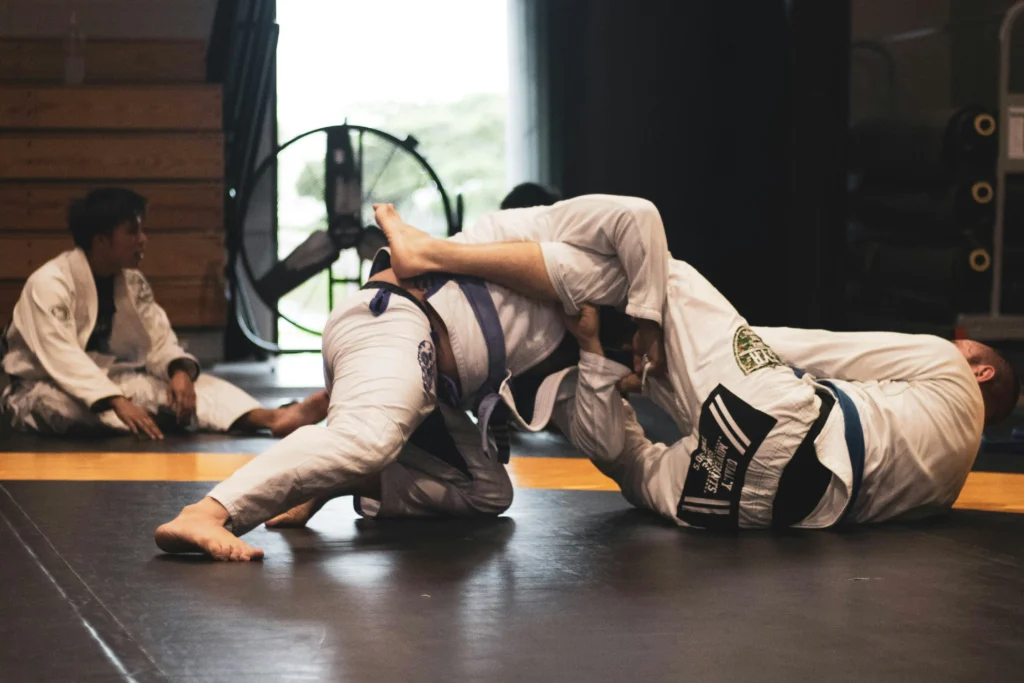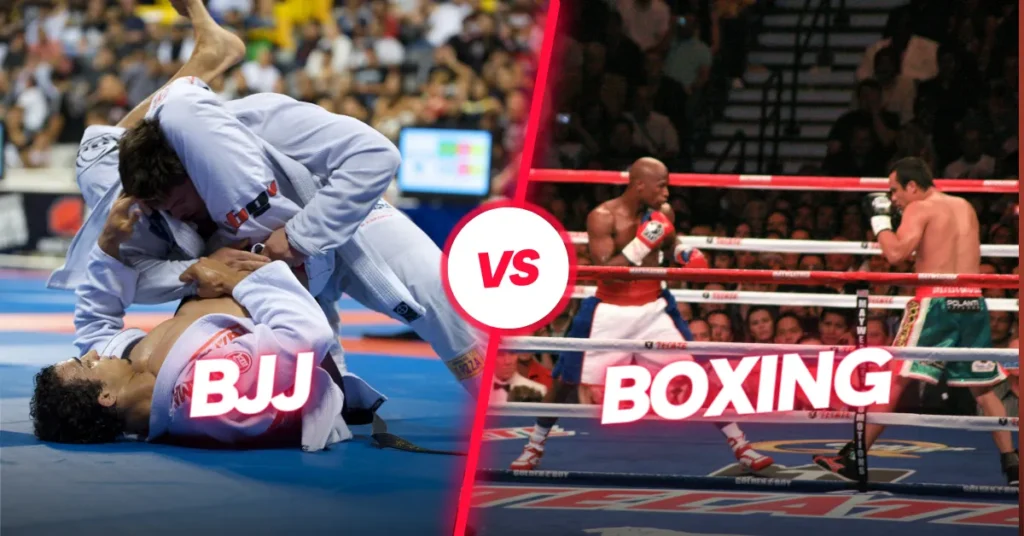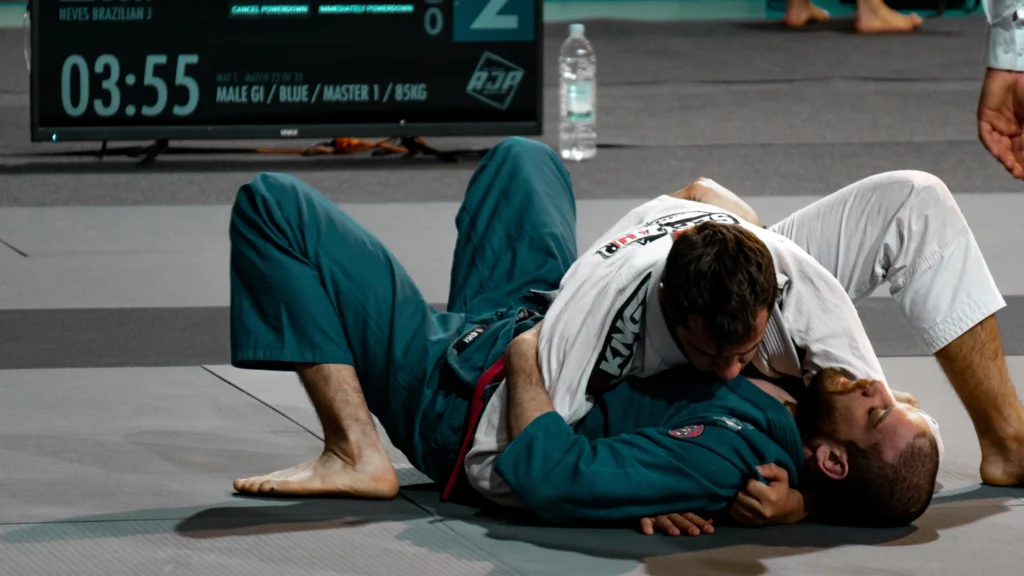Building strength and conditioning are essential for improving your Brazilian Jiu-Jitsu skills. Incorporating specific exercises into your training routine can help you enhance your technique and overall performance on the mat. Whether you’re unable to make it to the gym or simply prefer to train at home, there are plenty of effective BJJ workouts you can do in the comfort of your own space.
In this section, we will explore a variety of Brazilian Jiu-Jitsu exercises that can be easily performed at home. These exercises will target key areas such as strength, mobility, and conditioning, allowing you to continue your grappling training even without access to a traditional gym or training facility.
Table of Contents
Key Takeaways
- BJJ workouts at home can be just as effective as training in a gym or dojo.
- There are plenty of Brazilian Jiu-Jitsu exercises that can be done at home to enhance your skills.
- Home workout routines for BJJ can help build strength, improve mobility, and increase conditioning.
- Online BJJ classes and resources are available for those interested in guided instruction.
- Consistency and dedication are key to seeing progress in your BJJ skills through home workouts.
The Benefits of Strength Training for BJJ
Strength training plays a vital role in the world of Brazilian Jiu-Jitsu (BJJ). It offers numerous advantages for practitioners, including injury prevention, increased endurance, and improved overall performance. By incorporating a consistent strength training routine at home, individuals can stay fit, enhance their solo training, and follow a structured workout program.

One of the significant benefits of strength training for BJJ is injury prevention. By strengthening the muscles, tendons, and ligaments, practitioners can reduce the risk of common injuries associated with the sport. This includes improving joint stability, promoting better body mechanics, and developing core strength, all of which contribute to a more resilient and injury-resistant body.
Furthermore, strength training aids in increasing endurance, an essential component of BJJ. By focusing on cardiovascular conditioning and muscular endurance, individuals can improve their ability to sustain intense grappling sessions over extended periods. This heightened endurance translates into better performance during sparring and competitions.
Another advantage of strength training for BJJ is its ability to develop physical attributes that complement technical skills. Grip strength, for example, is crucial in BJJ for controlling opponents and executing techniques effectively. By incorporating grip-strengthening exercises into their routine, practitioners can enhance their ability to apply and maintain dominant holds.
Moreover, strength training helps increase overall power, enabling practitioners to generate explosive movements when executing takedowns or submissions. This explosive power can also provide an advantage in transitions and scrambles, allowing practitioners to outmaneuver their opponents with speed and force.
By participating in a structured strength training program, individuals can prioritize specific areas of improvement and focus on exercises that directly benefit their BJJ performance. They can tailor their workouts to target muscle groups involved in grappling, such as the core, legs, back, and shoulders. This targeted training translates into improved strength and stability in these areas, yielding greater effectiveness in technique execution.
With the rise of online resources and instructional videos, self-training for BJJ has become more accessible than ever. Practitioners can utilize solo jiu-jitsu drills and exercises designed for home workouts to enhance their skills outside the gym or academy. These drills focus on specific movements and techniques, allowing individuals to refine their mechanics and muscle memory.
Incorporating a comprehensive BJJ home workout program, which includes both strength training and solo drills, can help practitioners stay fit and constantly improve their skills. It provides a structured routine that targets various aspects of their game, including technique, strength, endurance, and flexibility.
Essential BJJ Strength Exercises for Home Workouts
Building Strength for BJJ
The first resource offers a bodyweight workout designed specifically for BJJ athletes. This equipment-free routine targets essential muscle groups, focusing on:
- Squatting: Develops leg power and stability for takedowns and guard retention.
- Hinging: Builds explosive power for throws and sweeps.
- Pushing: Improves upper body strength for guard passing and controlling your opponent.
- Pulling: Enhances grip strength and back muscles for submissions and control.
- Core: Strengthens core muscles crucial for overall BJJ performance.
Squatting Exercises
Boydweight squats (Difficulty Level: Intermediate to Advanced)
Bodyweight squats help strengthen the quadriceps, hamstrings, glutes, and core muscles. They improve lower body strength, mobility, and stability, which are essential for movements in Brazilian Jiu Jitsu.
Cossack squats (Difficulty Level: Intermediate)
Cossack squats are a lateral movement exercise that targets the inner and outer thighs, hips, and glutes. They also help improve hip mobility and flexibility. While cossack squats are more accessible than shrimp squats for beginners, they still require a certain level of lower body strength and mobility. Beginners can modify the depth or use support if needed to perform cossack squats effectively.
Lateral hops (Difficulty Level: Beginner to Intermediate)
Lateral hops are a plyometric exercise that enhances agility, coordination, and lower body power. They involve jumping laterally from side to side, which can improve your explosiveness and footwork for BJJ. Lateral hops can be suitable for beginners with some basic fitness foundation, but proper landing mechanics and control are essential to prevent injury. Beginners can start with smaller jumps and gradually increase intensity as they progress.
Hinging Exercises
Bridges (Difficulty Level: Beginner to Intermediate)
Brides are a type of exercise that primarily targets the glutes, hamstrings, and lower back muscles. They help improve hip mobility, core stability, and posterior chain strength, all of which are essential for moves in Brazilian Jiu Jitsu. There are different types of bridges, such as basic bridges, single-leg bridges, and weighted bridges.
Superman hold (Difficulty Level: Beginner to Intermediate)
Superman holds are a type of exercise that targets the lower back, glutes, and upper back muscles. They help improve spinal erector strength, posture, and overall back stability, which can be beneficial for BJJ practitioners to prevent injuries and enhance performance.
Pushing Exercises
Push-Ups (Difficulty Level: Beginner to Intermediate)
Push-ups, a fundamental bodyweight exercise, go beyond aesthetics for BJJ practitioners. Regular practice enhances upper body strength vital for techniques like shrimping and maintaining control. Engaging core muscles improves stability during grappling, contributing to a well-rounded skill set. Push-up-induced muscular endurance allows sustained effort in training and matches, providing a competitive edge.
Dips (Difficulty Level: Intermediate)
Dips, a bodyweight exercise, focus on triceps and chest, crucial for BJJ arm strength in maneuvers like arm bars and chokes. Beyond isolated muscle development, dips enhance shoulder stability, vital for overhead movements in BJJ. Engaging multiple muscle groups simultaneously, dips promote functional strength, directly benefiting grappling performance. Incorporating dips into training fosters a well-rounded strength foundation essential for success in Brazilian Jiu-Jitsu.
Wall Presses (Difficulty Level: Beginner)
Wall presses, a versatile bodyweight exercise, target shoulders and chest, enhancing shoulder stability crucial for throws and control in BJJ. Their scalability makes them accessible for beginners and offers progression for advanced practitioners. As individuals advance in BJJ, modifying wall presses continually challenges strength and stability. Additionally, wall presses contribute to developing body awareness and alignment, vital for maintaining proper posture and technique in various BJJ movements.
Pulling Exercises
Pull-Ups (Difficulty Level: Intermediate to Advanced)
Building Upper Body Dominance Pull-ups target the latissimus dorsi, crucial for upper body strength integral to successful execution of BJJ techniques. Beyond muscle development, pull-ups enhance grip strength, a key element for controlling opponents during grappling, and strengthen forearms, contributing to improved grip and control on the mat.
Chin-Ups/Negatives (Difficulty Level: Intermediate to Advanced)
Sculpting Arms and Fortifying the Neck Chin-ups focus on biceps development, enhancing arm size and strength essential for executing effective chokes and arm bars in BJJ. Negative chin-ups, on the other hand, engage neck muscles, playing a crucial role in injury prevention and maintaining posture during intense BJJ sessions.
Renegade Rows (Difficulty Level: Beginner to Intermediate)
Core Power and Enhanced Control Renegade rows, combining a rowing motion with a plank position, engage core muscles, promoting stability and strength vital for success in BJJ. This exercise not only strengthens the core but also challenges balance and coordination, translating to improved control during grappling exchanges.
Core Exercises
Bicycle Kicks (Difficulty Level: Beginner to Intermediate)
A Symphony of Strength and Endurance Bicycle Kicks transcend mere cardiovascular benefits, playing a pivotal role in BJJ conditioning. Engaging obliques fosters rotational strength, crucial for executing twisting movements in BJJ. Improved hip flexor flexibility is cultivated, enhancing readiness for diverse ground techniques. Contributing to cardiovascular endurance, Bicycle Kicks fortify stamina during intense sparring.
Plank Walkouts (Difficulty Level: Intermediate to Advanced)
Dynamic Symphony for Full-Body Mastery Plank Walkouts compose a dynamic symphony of strength applicable to the nuanced world of BJJ. Engaging multiple muscle groups simultaneously orchestrates overall strength and stability. Dynamic core activation within the exercise refines both strength and endurance. Scalability renders Plank Walkouts accessible to practitioners of all levels, from novices to advanced.
Russian Twists (Difficulty Level: Intermediate to Advanced)
Core Mastery for BJJ Artistry Russian Twists spotlight core mastery, a cornerstone for success in the art of Brazilian Jiu-Jitsu. Oblique strength is honed, unlocking rotational power vital for BJJ movements like guard passes. Core stability is fortified, empowering practitioners to maintain control during twisting actions. Enhanced torso mobility resulting from Russian Twists facilitates the execution of techniques demanding precision in twisting and turning.
Sharpening Your Movement with Solo Drills
The second types of home workouts delve into five solo drills that can significantly benefit beginners.
Shrimping
This fundamental movement drill helps improve hip mobility and teaches you how to create space between you and your imaginary opponent by moving your hips away.
Granby Roll
Practice the Granby roll to improve your ability to recover guard and escape from bottom positions effectively.
Credit: DICK’S Sporting Goods
Technical Stand-Up
Work on the technical stand-up to practice getting back on your feet quickly from various ground positions, simulating getting up safely during a match.
Hip Escapes
Focus on hip escapes to enhance your hip movement and develop the ability to create space and escape from under your opponent.
Shadow Rolling
Shadow rolling is a solo BJJ drill where you visualize and perform techniques as if rolling with an opponent. This enhances muscle memory, technique visualization, and overall fluidity. Focus on smooth transitions, proper form, and realistic scenarios to boost skills when training alone at home.
Integrating these essential strength exercises into your home workouts can greatly enhance your BJJ performance, mobility, and overall strength and conditioning. Remember to start with lighter weights and gradually increase intensity as you progress. Stay consistent with your training routine and focus on proper form to maximize the benefits.
Remember
- Warm-up before your workout and cool down afterwards.
- Focus on proper form over weight.
- Listen to your body and take rest days when needed.
- Consistency is key! Aim for 2-3 workouts per week for optimal results.
The Importance of Consistency and Progression
Consistency and progression play vital roles in strength training for BJJ at home. By regularly performing the exercises and gradually increasing intensity or adding resistance, practitioners can achieve better results in their training.
Consistency ensures that the body develops the necessary strength and endurance to meet the demands of Brazilian Jiu-Jitsu. By staying committed to a diligent training schedule, practitioners can build a solid foundation of strength and improve their overall performance on the mat.
“Consistency is the key to success in any endeavor, and strength training for BJJ is no exception. By prioritizing your workouts and making them a regular part of your routine, you can reap the benefits of improved strength and conditioning.”
In addition to consistency, progression is essential for continuous growth. Gradually increasing the difficulty of exercises helps challenge the muscles, promoting strength gains and preventing plateaus. Whether it’s adding more reps, increasing weights, or incorporating more advanced variations, progression keeps the body adapting and evolving.
For those seeking structure and guidance in their BJJ strength training journey, following a structured workout program can be highly beneficial. These programs are designed to address the specific needs of BJJ practitioners, targeting areas such as grip strength, core stability, and explosive power.
| Methods for Consistency and Progression in BJJ Strength Training | Pros | Cons |
|---|---|---|
| Seeking guidance from a BJJ black belt | – Access to expert knowledge and experience – Specific guidance tailored to BJJ needs | – Cost associated with private lessons or coaching – Limited availability depending on location |
| Joining a BJJ gym | – Access to professional instructors and training partners – Structured classes and workouts | – Membership fees and commuting time – Limited availability depending on location |
| Online BJJ resources and programs | – Convenience of training from home – Wide range of programs and instructional materials available | – Lack of in-person guidance and feedback – Self-discipline required to stay consistent |
Consistency and progression, coupled with the support of a BJJ black belt or a BJJ gym, can provide the necessary accountability and motivation to stay committed to strength training for BJJ at home. By setting clear goals, tracking progress, and continuously challenging oneself, practitioners can unlock their full potential and elevate their performance on the mat.
Conclusion
Incorporating strength training exercises into your BJJ training at home is a game-changer for improving your skills and performance on the mat. By following a regular routine and targeting key areas, you can enhance your technique and take your Brazilian Jiu-Jitsu game to the next level. With dedication and consistency, you have the power to improve your BJJ prowess.
Strength training not only builds physical attributes like grip strength and power but also helps prevent injuries and increase endurance. By focusing on exercises that target specific areas important for BJJ, such as deadlifts, goblet squats, and lateral lunges, you can develop the strength and stability needed to excel in your grappling.
Remember, improvement in BJJ comes from a holistic approach. Seeking guidance when needed, whether from a coach or fellow practitioners, can provide valuable insights and help you refine your technique. Stay committed to your training, stay focused on your goals, and keep pushing yourself to become the best BJJ practitioner you can be. Through consistent and effective BJJ workouts, you’ll find yourself continually improving and achieving new milestones. Train hard, train smart, and watch your skills soar!
FAQ
What are some effective exercises for BJJ workouts at home?
Effective exercises for BJJ workouts at home include deadlifts, goblet squats, lateral lunges, dumbbell rows, leopard crawls, and farmer carries.
Why is strength training important for Brazilian Jiu-Jitsu?
Strength training is important for Brazilian Jiu-Jitsu because it helps prevent injuries, increases endurance, and improves overall performance. It also helps build physical attributes such as grip strength and power, which complement technical skills.
How can strength training benefit my solo training for BJJ?
Incorporating strength training exercises into your solo training for BJJ can help you build overall strength, enhance lower body strength and stability, improve grip strength, and develop full-body strength and stability.
How can I ensure progress in my strength training for BJJ at home?
Consistency and progression are key factors in strength training for BJJ at home. Regularly performing the exercises and gradually increasing intensity or adding resistance will result in better results. Seeking guidance from a BJJ black belt, following a structured workout program, or joining a BJJ gym can also provide additional support and accountability.
How can strength training improve my skills and performance in Brazilian Jiu-Jitsu?
By incorporating strength training exercises into your BJJ workouts at home, you can significantly improve your skills and performance on the mat. It helps enhance your technique, increase your strength, and take your Brazilian Jiu-Jitsu game to the next level.



